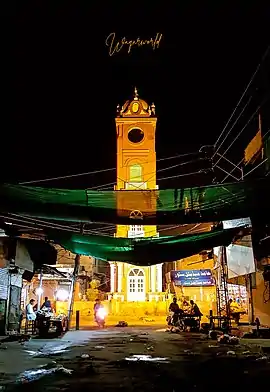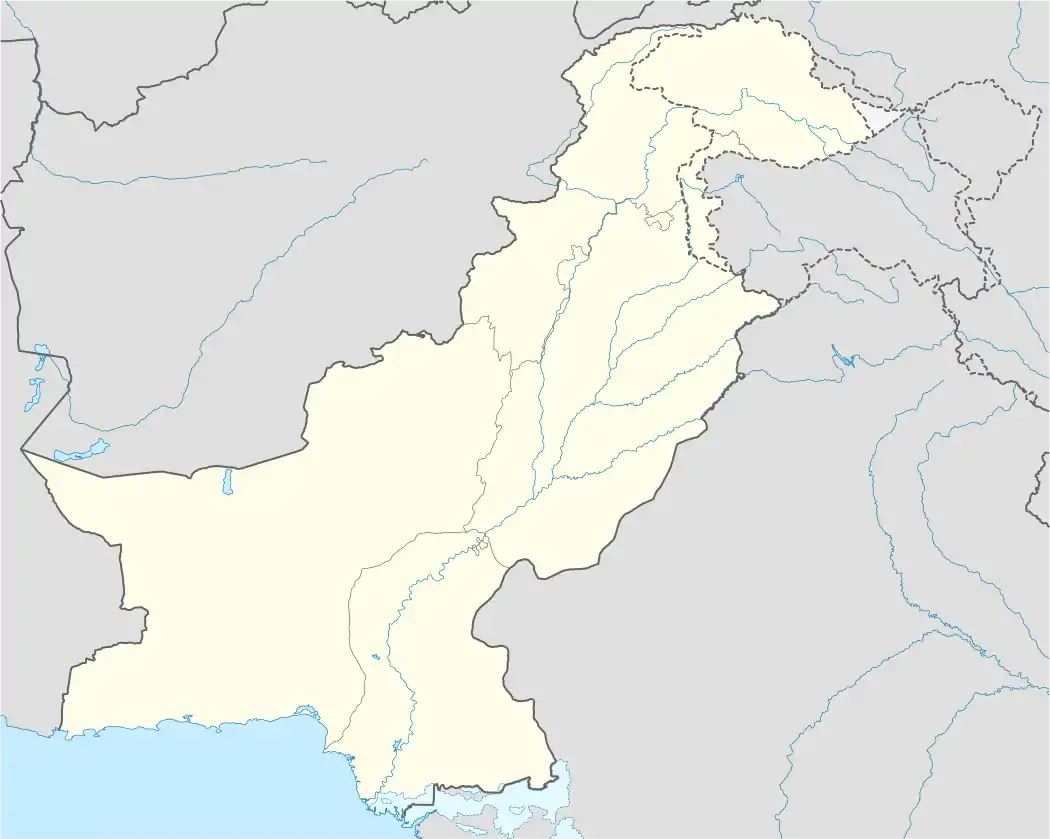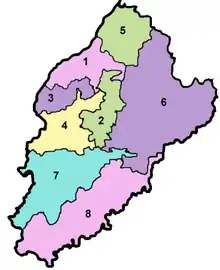Samundri
Samundri (Urdu, Punjabi: سمندری) is a city and headquarters of Samundri Tehsil located in Faisalabad District of Punjab province, Pakistan.[2] It is the 55th largest city of Pakistan by population according to the 2017 census.
Samundri
سمندری | |
|---|---|
City | |
 Clock Tower, Samundri | |
 Samundri Location in Pakistan | |
| Coordinates: 31°03′45″N 72°57′15″E | |
| Country | Pakistan |
| Province | Punjab |
| District | Faisalabad |
| Tehsil | Samundri |
| Population | |
| • City | 156,991 |
| • Rank | 55th, Pakistan |
| Time zone | UTC+5 (PKT) |
History
Samundri was on a major trade route during the reign of Sher Shah Suri. The present site of Samundri city was founded in 1887 as Chak No. 533 G.B. Later it was renamed as Seh Mundri because of three Hindu mandirs in the area. The word Seh means Three in Persian and a Mandir is Sanskrit word for a temple. In 1887 there were three Hindu shrines in this area but now what remains of the houses the Government Primary School No 4. Migration between India and Pakistan was continuous before the independence. By the 1900s Western Punjab was predominantly Muslim and supported the Muslim League and Pakistan Movement. After the independence in August 1947, the minority Hindus and Sikhs migrated to India while the Muslim refugees from Eastern Punjab in India settled in Western Punjab and across Pakistan.[3] Today Samundri is known for its contributions to Pakistan's kabadi team provide dozens of big names especially from Chak 176 G.B and 478 G.B. It has many Gujjar, rajput and jatt farmers who tend to be larger in size than elsewhere.
Geography
Samundri is located at 31°03'45"N 72°57'15"E (31.063, 72.954), at an altitude of 168 metres (429 ft), and is 45 km from Faisalabad, 66 km from Jhang, 30 km from Gojra and just 15 km from Tandlianwala. The upcoming Karachi-Lahore Motorway will pass through neighborhood of Tandlianwala known as Samundari Interchange Km 1016 on Samundari-Tandlianwala Road. Then it will be easily accessible from Lahore and Multan. The Post Code of Samundari is 37300. There are famous 14 chaks of Gujjars. Majority of the population is of Gujjars. They are distinguished by their unique Punjabi accent and are recognized easily by their accents.
Economy
Samundri is home to a major grain, whole corn & sugar market. Sugarcane and wheat are the major crops of the area, while corn is the most-traded good locally. Rice is also grown here but, due to water shortages, less farmers are deciding to grow it. Vegetables are grown on many hectares and fulfilling 50% of the demand.
The Anarkali Bazaar is the main commercial market of the city, and the Jinnah Market is the oldest. Other markets in the city include Jamat Ali Bazaar, Katchery Bazaar, Mandi Bazaar, Nehar Bazaar, Qasim Bazaar, Kashmiri Bazaar, Sunny Plaza and Chaki Bazaar.
Samundri is also known for its custom truck painting business.
Major Banks in Samundari:
Education
Divisional Public School, New Afaq Higher Secondary School, Spirit School, and College and Saleemi Vital Education High School Samundri provides education in this area.
There are two Post Graduate colleges in Samundri, one for boys and another for girls. There is a commerce college as well being run by TEVTA in a private building acquired on rent. However, a new building is built for Commerce and Technical studies near Chak 465 and arch valley.
There are four Govt. high schools in total; two for boys [Govt. High School No.1, Govt. High School No.2] and two for girls [Govt. High School No.1, Govt. High School No.2]Govt High School 479 GB and a number of private schools.
The Al-Karemia Educational Welfare Society (Regd.) established the Deans Shiblee College in Samundri in 2004. The college has separate campuses for girls and boys. The Deans Shiblee College is registered with the Board of Intermediate & Secondary Education, Faisalabad (B.I.S.E. Faisalabad) and the Directorate of Education (Colleges), Faisalabad for its F.A., F.Sc., I.C.S. and I.Com. programs, and affiliated with the University of the Punjab, Lahore for its B.Com., B.A. IT, B.Ed., M.Ed., M.Com., M.A. Economics and M.A. Physical Education programmes.
One Academy Samundri is one leading institute providing international level science education in Samundri, One Academy offer Science and English education from 9th to M.Sc.and O/A level also offer examination preparation classes like PPSC Lecturer and Assistant Professor, CSS, IELTS, MDCAT, SAT.
The Punjab College started classes in 2012 having programs of F.A, F.Sc, I.Cs, I.Com, B.Sc, B.A and B.Com. The establishment of the Virtual University Campus (IEMS) in Samundri allows students to study for various HEC approved and recognized degrees, including Bachelor of Business Administration [BBA], Masters of Business Administration [MBA], MCS degree[MCS], Bachelor of Computer Science [BSCS], Bachelor of Science in Information Technology [BSIT], [Bachelor of Commerce [B.Com], Bachelor of Science [B.Sc]. Educational institutes of Samundri are mother institutes of a lot of competent engineers and doctors.
Languages
The population speaks Punjabi as mother tongue while the national language Urdu is also widely spoken. The Arabic is taught in Madrasahs and Masjids as religious language. English as the official language is taught in all schools.
Health
There are about ten public and private hospitals in Samundri. They provide quality health treatment to patients. Famous hospitals are:
- Tehsil Headquarter Hospital Samundri
- Lady Health Worker Clinic
- Al-Hassan Medical & Surgical Centre
- Sughra Siddique Hospital & Health Insaf Card Center Samundri.
- Ravi Hospital Samundri.
Notable residents
- Prithviraj Kapoor, actor and director
References
| Wikivoyage has a travel guide for Samundri. |
- "PAKISTAN: Provinces and Major Cities". PAKISTAN: Provinces and Major Cities. citypopulation.de. Retrieved 4 May 2020.
- Towns & Unions in the City District of Faisalabad - Government of Pakistan Archived 2012-03-26 at the Wayback Machine
- Dube, I. &. S. (2009). From ancient to modern: Religion, power, and community in India hardcover. Oxford University Press.

